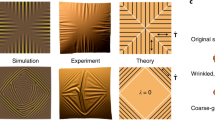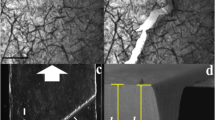Abstract
Stiff thin films on soft substrates are both ancient and commonplace in nature; for instance, animal skin comprises a stiff epidermis attached to a soft dermis. Although more recent and rare, artificial skins are increasingly used in a broad range of applications, including flexible electronics1, tunable diffraction gratings2,3, force spectroscopy in cells4, modern metrology methods5, and other devices6,7,8. Here we show that model elastomeric artificial skins wrinkle in a hierarchical pattern consisting of self-similar buckles extending over five orders of magnitude in length scale, ranging from a few nanometres to a few millimetres. We provide a mechanism for the formation of this hierarchical wrinkling pattern, and quantify our experimental findings with both computations and a simple scaling theory. This allows us to harness the substrates for applications. In particular, we show how to use the multigeneration-wrinkled substrate for separating particles based on their size, while simultaneously forming linear chains of monodisperse particles.
This is a preview of subscription content, access via your institution
Access options
Subscribe to this journal
Receive 12 print issues and online access
$259.00 per year
only $21.58 per issue
Buy this article
- Purchase on Springer Link
- Instant access to full article PDF
Prices may be subject to local taxes which are calculated during checkout





Similar content being viewed by others
References
Hamers, R. J. Flexible electronic futures. Nature 412, 489–490 (2001).
Lim, J. H., Lee, K. S., Kim, J. C. & Lee, B. H. Tunable fiber gratings fabricated in photonic crystal fiber by use of mechanical pressure. Opt. Lett. 29, 331–333 (2004).
Wong, C. W. et al. Strain-tunable silicon photonic band gap microcavities in optical waveguides. Appl. Phys. Lett. 84, 1242–1244 (2004).
Harris, A. K., Wild, P. & Stopak, D. Silicone rubber substrata: a new wrinkle in the study of cell locomotion. Science 208, 177 (1980).
Stafford, C. M. et al. A buckling-based metrology for measuring the elastic moduli of polymeric thin films. Nature Mater. 3, 545–550 (2004).
Bowden, N., Brittain, S., Evans, A. G., Hutchinson, J. W. & Whitesides, G. W. Spontaneous formation of ordered structures in thin films of metals supported on an elastomeric polymer. Nature 393, 146–149 (1998).
Bowden, N., Huck, W. T. S, Paul, K. & Whitesides, G. W. The controlled formation of ordered, sinusoidal structures by plasma oxidation of an elastomeric polymer. Appl. Phys. Lett. 75, 2557–2559 (1999).
Huck, W. T. S., Bowden, N., Onck, P., Pardoen, T., Hutchinson, J. W. & Whitesides, G. W. Ordering of spontaneously formed buckles on planar surfaces. Langmuir 16, 3497–3501 (2000).
Cerda, E. & Mahadevan, L. Geometry and physics of wrinkling. Phys. Rev. Lett. 90, 074302 (2003).
Hedden, R. C., Saxena, H. & Cohen, C. Mechanical properties and swelling behavior of end-linked poly(diethylsiloxane) networks. Macromolecules 33, 8676–8684 (2000).
Genzer, J., Fischer, D. A. & Efimenko, K. Fabricating two-dimensional molecular gradients via asymmetric deformation of uniformly-coated elastomer sheets. Adv. Mater. 15, 1545–1547 (2003).
Ouyang, M., Yuan, C., Muisener, R. J., Boulares, A. & Koberstein, J. T. Conversion of some siloxane polymers to silicon oxide by UV/ozone photochemical processes. Chem. Mater. 12, 1591–1596 (2000).
Efimenko, K., Wallace, W. E. & Genzer, J. Surface modification of Sylgard-184 poly(dimethyl siloxane) networks by ultraviolet and ultraviolet/ozone treatment. J. Colloid Interface Sci. 254, 306–315 (2002).
Allen, H. G. Analysis and Design of Structural Sandwich Panels (Pergamon, New York, 1969).
Landau, L. D. & Lifshitz, L. Theory of Elasticity 3rd edn (Pergamon, New York, 1986).
Cerda, E. & Mahadevan, L. Wrinkling of an elastic sheet under tension. Nature 419, 579–580 (2003).
Babler, W. J. Embryologic development of epidermal ridges and their configurations. Birth Defects Orig. 27, 95–112 (1991).
Kücken, M. & Newell, A. C. A model for fingerprint formation. Europhys. Lett. 68, 141–146 (2004).
Price, N. J. & Cosgrove, J. W. Analysis of Geological Structures (Cambridge Univ. Press, Cambridge, 1990).
Huddleston, P. J. & Lan, L. Information from fold shapes. J. Struct. Geology 15, 253–264 (1993).
Harrison, C., Stafford, C. M., Zhang, W. & Karim, A. Sinusoidal phase grating created by a tunably buckled surface. Appl. Phys. Lett. 85, 4016–4018 (2004).
Ulman, A. Formation and structure of self-assembled monolayers. Chem. Rev. 96, 1533–1554 (1996).
Schreiber, F. Structure and growth of self-assembling monolayers. Prog. Surf. Sci. 65, 151–256 (2000).
Zhao, B. & Brittain, W. J. Polymer brushes: surface-immobilized macromolecules. Prog. Polym. Sci. 25, 677–710 (2000).
Edmondson, S., Osborne, V. L. & Huck, W. T. S. Polymer brushes via surface-initiated polymerizations. Chem. Soc. Rev. 33, 14–22 (2004).
Teixeira, A. I., Abrams, G. A., Bertics, P. J., Murphy, C. J. & Nealey, P. F. Epithelial contact guidance on well-defined micro- and nanostructured substrates. J. Cell. Sci. 116, 1881–1892 (2003).
Hynes, R. O. & Lander, A. D. Contact and adhesive specificities in the associations, migrations, and targeting of cells and axons. Cell 68, 303–322 (1992).
Patel, S. K., Malone, S., Cohen, C., Gilmor, K. R. & Colby, R. H. Elastic modulus and equilibrium swelling of poly(dimethylsiloxane) networks. Macromolecules 25, 5241–5251 (1992).
Manias, E., Chen, J., Fang, N. & Zhang, X. Polymeric MEMS components with tunable stiffness. Appl. Phys. Lett. 79, 1700–1702 (2001).
Radmacher, M., Fritz, M., Cleveland, J. P., Walters, D. A. & Hansma, P. K. Imaging adhesion forces and elasticity of lysozyme adsorbed on mica with the atomic force microscope. Langmuir 10, 3809–3814 (1994).
Rotsch, C & Radmacher, M. Mapping local electrostatic forces with the atomic force microscope. Langmuir 13, 2825–2832 (1997).
Acknowledgements
The work was supported by the grants from the Camille & Henry Dreyfus Foundation (J.G.), the NER Program at the National Science Foundation (J.G., E.M.), and the Office of Naval Research (J.G., L.M.). We thank O.D. Velev for fruitful discussions.
Author information
Authors and Affiliations
Corresponding authors
Ethics declarations
Competing interests
The authors declare no competing financial interests.
Supplementary information
Supplementary Information
Supplementary text (PDF 54 kb)
Supplementary Information
Supplementary animation (GIF 3769 kb)
Rights and permissions
About this article
Cite this article
Efimenko, K., Rackaitis, M., Manias, E. et al. Nested self-similar wrinkling patterns in skins. Nature Mater 4, 293–297 (2005). https://doi.org/10.1038/nmat1342
Received:
Accepted:
Published:
Issue Date:
DOI: https://doi.org/10.1038/nmat1342
This article is cited by
-
High sensitivity capacitive flexible pressure sensor based on PDMS double wrinkled microstructure
Journal of Materials Science: Materials in Electronics (2024)
-
Fabrication of plane-type axon guidance substrates by applying diamond-like carbon thin film deposition
Scientific Reports (2023)
-
Water nanolayer facilitated solitary-wave-like blisters in MoS2 thin films
Nature Communications (2023)
-
Bioinspired Strategies for Stretchable Conductors
Chemical Research in Chinese Universities (2023)
-
Photodimerization induced hierarchical and asymmetric iontronic micropatterns
Nature Communications (2022)



